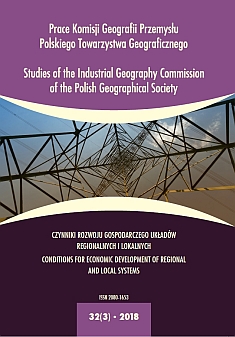Industries in Wrocław (Poland)
DOI:
https://doi.org/10.24917/20801653.323.16Keywords:
culture industries, SWOT analysis, WroclawAbstract
The aim of the work is to characterise cultural industries in Wrocław. In the first part of the work the diagnosis of culture industries was presented; the diagnosis was given for: publishing, music, film and television industries. The analysis was prepared based on statistical data, literature and information from representatives of the Wrocław culture. The author realised the aim of the article referring to the size, structure, quantity and the market position of analysed entities. Conclusions were aggregated using the SWOT analysis. Selected conclusions are as follows: (1) the development of film industry does not reflect the historical potential; new ideas and trends are more important, (2) influence of cultural industries on labour market in Wrocław is rather week, (3) the highest growth of new created entities is noticed in the media sector, including publishing of computer games.Downloads
Metrics
References
Drobniak, A. (2017). Hybrydyzacja rozwoju – prężność i dynamika rozwoju polskich miast. Prace Naukowe Uniwersytetu Ekonomicznego w Katowicach, 467, 22–31.
Drobniak, A., Wrana, K. (2008). Przemysły kultury jako czynnik konkurencyjności miast. W: J. Słodczyk, E. Szafranek (red.). Mechanizmy i uwarunkowania budowania konkurencyjności miast. Opole: Uniwersytet Opolski, 101–111.
Economy of culture in Europe – Report (2011) (2012, 23 lutego). Pozyskano z www.keanet.eu/ en/ecoculturepage.html Gross, J.S. (2016). Hybridization and Urban Governance: Malleability, Modality, or Mind-Set? Urban Affairs Review, 53(3), 559–577.
Klasik, A. (2011). The Culture Sector and Creative Industries as a New Foundation of Development of Large Cities and Urban Agglomerations. W: A. Klasik (red.). The Cities and Agglomerations Development based on the Culture Sector and Creative Industries. Studia Regionalia, 30.
Patkar, M.R., Keskar, Y.M. (2014). Hybridization as a New Paradigm of Urban Development in metropolitan city, a case of Pune City, India. International Journal of Innovative Research in Science, Engineering and Technology, 3(1), 8529–8536.
Murzyn-Kupisz, M. (2016). Instytucje muzealne z perspektywy ekonomii kultury. Współpraca J. Działek. Kraków: Wydawnictwo Universitas.
Namyślak, B. (2014). Sektor kreatywny w gospodarce – ujęcie teoretyczne. Gospodarka Narodowa, 2, 153–176.
Polko, A., Wrana, K. (2009). Przemysły kultury i ich lokalne klastry. Przypadek Bytomia. W: A. Klasik (red.). Kreatywne miasta i aglomeracje. Studia przypadków.P race Naukowe Akademii Ekonomicznej w Katowicach, 237–256.
Stachowiak, K. (2015). Problemy metodologiczne badania sektora kreatywnego. Rozwój Regionalny i Polityka Regionalna, 30, 9–46.
Stryjakiewicz, T., Stachowiak, K. (2010). Sektor kreatywny w poznańskim obszarze metropolitalnym. Tom 1: Uwarunkowania, poziom i dynamika rozwoju sektora kreatywnego w poznańskim obszarze metropolitalnym. Poznań: Bogucki Wydawnictwo Naukowe.
Throsby, D. (2010). Ekonomia i kultura. Warszawa: Narodowe Centrum Kultury.
Towse, R. (2011). Ekonomia kultury. Kompendium. Warszawa: Narodowe Centrum Kultury.
UNESCO. Framework for Cultural Statistics (2009) (2011, 22 września). Pozyskano z http://unesdoc.unesco.org/images/0018/001840/184082e.pdf
Downloads
Published
How to Cite
Issue
Section
License
Articles are published under the terms of the Creative Commons License (CC BY-ND 4.0; Attribution– NoDerivs).

